Anchor text backlinks play a pivotal role in how search engines perceive your website and influence its ranking on search results pages
By using descriptive and relevant anchor text, you inform search engines about the key topics your website covers, thereby enhancing its visibility in organic search results.
So, how can you ensure your anchor text aligns with your website’s SEO goals?
In this article, OctopusWriters will guide you through the essentials of anchor text backlinks, their significance in SEO, and best practices for optimizing them to boost your site’s rankings.
What Is Anchor Text?
Anchor Text Backlinks, also known as link text, are the clickable, highlighted text within a hyperlink that directs users to a different page or resource. This can lead to another webpage, a different section of the same page, or even trigger a user’s default email client to open.
Typically styled with underlining or bold to stand out from other text, anchor text is essential for both usability and SEO. This article focuses specifically on anchor text used for linking to external or internal webpages.
Effective anchor text gives users an idea of what they’ll see when they click and also provides search engines with context on the content of the linked page.
Example Anchor Text Backlinks
Let’s say you want to link to a guide on keyword research. Your anchor text could be:
“Learn how to perform effective keyword research.”
<a href="https://www.example.com/keyword-research-guide">Learn how to perform effective keyword research</a>
In this example:
- Anchor Text: “Learn how to perform effective keyword research” (this is the visible, clickable text).
- Link Destination: “https://www.example.com/keyword-research-guide” (the URL it links to).
When users click this anchor text, they’ll be directed to the keyword research guide. The HTML <a> tag defines the link, and the href attribute specifies the URL.
Why Are Anchor Text Backlinks Important For SEO?
Anchor text plays a crucial role in SEO by signaling to search engines what a page is about. Using relevant keywords in anchor text can improve a page’s visibility in search engine results pages (SERPs), increasing the likelihood that it will rank higher for those terms. This not only draws organic or paid traffic but also enhances the page’s clarity and value to visitors.

Ultimately, well-optimized anchor text contributes to better-quality backlinks, which can significantly improve SEO performance. High-quality anchor links from authoritative sources mean higher rankings, improved click-through rates, and more conversions over time.
Anchor text serves many purposes, but when it comes to link-building, two key benefits stand out:
More Link Juice
Google uses anchor text to gauge the relevance of a link. While overly optimized keyword phrases are now discouraged, naturally incorporated keywords still hold value. The right anchor text provides more “link juice” to the page, strengthening its authority and relevance. Some consider this a vital factor in backlink quality, second only to the authority of the referring domain.
Better Clickability
Anchor text is about more than SEO; it also has practical value. Effective anchor text catches a user’s attention and makes the link more appealing to click. This can drive additional traffic and engagement, which may lead to direct conversions or amplify positive SEO signals.
The Evolution Of Anchor Text Backlinks
Anchor text backlinks have been central to SEO strategy since search engines first appeared. However, the approach to anchor text has evolved considerably over the years.
As with many SEO elements, anchor text has seen major shifts, especially in the past decade.
Before 2011, using keyword-heavy anchor text was widely recommended.
If your keyword was “organic skincare products,” you’d be advised to use anchor phrases like:
- Organic skincare products
- Buy organic skincare products
- Organic skincare products buy
- Buy organic skincare products online
- For more on organic skincare products, visit: organicskincare.com
- Organic skincare products: organicskincare.com
- Image link alt = organicskincare.com
This strategy aimed to “crack the code” of the Google algorithm. There was no intent to deceive; it was simply the norm for effective SEO back then. SEO experts figured out how to leverage the algorithm, and many followed suit.
In those days, SEO often prioritized the algorithm over user experience. Keyword-heavy, exact-match anchor text could boost rankings and increase visibility on SERPs.
However, it often looked clunky and unnatural. Google noticed this widespread manipulation and made significant changes to discourage it.
In April 2012, the first Penguin update rolled out.
Suddenly, sites using the same repetitive, keyword-rich anchor text saw their rankings drop.
As rankings fell, so did traffic and, inevitably, revenue. The old model of anchor text optimization quickly became outdated.
Since the initial Penguin update, Google has focused more on improving user experience and reducing spammy tactics.
Anchor text remains essential in SEO, but the approach has changed. Today, best practices involve using natural keyword ratios, considering the surrounding content, and avoiding exact matches for every link. This approach creates a more balanced, user-friendly experience.
What Is The Significance Of Varying Your Anchor Text?
Beyond achieving a high anchor text variation ratio, it’s crucial to diversify the types of anchor text you employ. This practice helps prevent keyword stuffing and enhances your website’s ranking in search engine results pages (SERPs).
Moreover, there are numerous ways to experiment with different variations of the same keywords on your site.
For example, if someone searches for “top coffee shops,” they might encounter links such as:
- Top Coffee Shops in My Area
- The Best Coffee Spots Nearby
- Our Favorite Cafés for Coffee Lovers
Each variation carries its own nuance and context, leading Google to rank them differently when assessed by its algorithms.
15 Varieties Of Anchor Text
Having discussed the significance of anchor text in link building and its evolution, let’s delve into the various types of anchor text you might encounter.
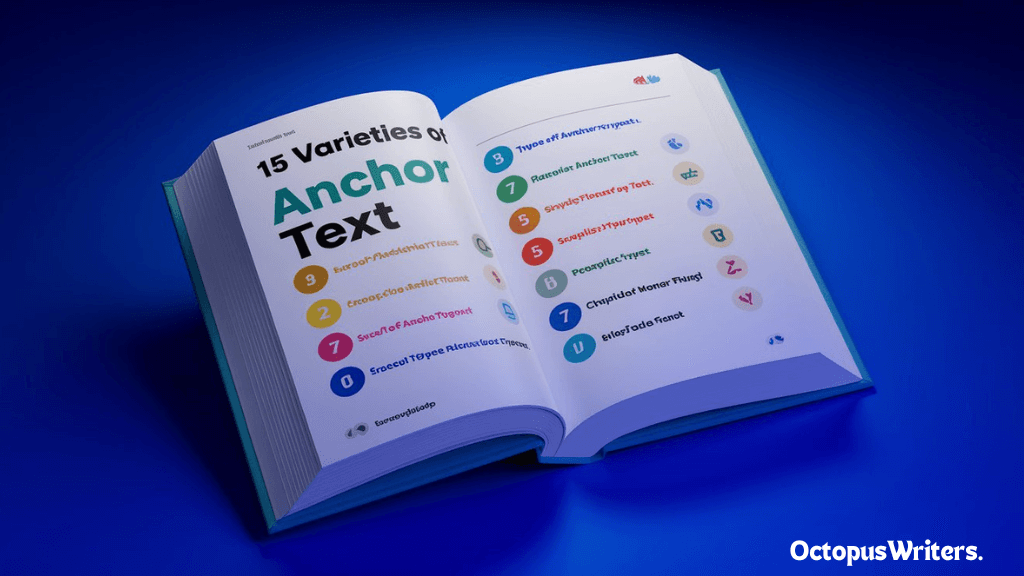
Branded Anchors
Branded anchors feature your brand’s name prominently. Examples include:
- OctopusWriters.com
- Google.com
- Amazon
- Home Depot
These anchors are powerful and safe to use, but obtaining them can be challenging during link-building efforts. Publishers often shy away from branded keyword anchors due to their overt nature. Therefore, it’s essential to have a valid reason for using them, as their presence could disrupt the article’s flow.
WebsiteName.com
This type of anchor text serves to promote your website and clarify to visitors that your site is the content’s source.
While it can positively impact both long-term rankings and traffic, overusing it may lead to a spammy environment, potentially frustrating users who explore your site.
Generic Anchor Text (Call-to-Action)
Generic anchor text lacks specific keywords and includes phrases like “click here” or “read more.”
These anchors are useful for enhancing readability and preventing keyword over-optimization while still aiding search engine rankings. Generic or CTA anchors contain prompts that encourage users to visit a page, such as:
- Buy now
- Visit us today
- Explore this link
- Check this out
- Try this product
While generic CTA anchors don’t contribute much to brand recognition, they provide clear navigation for users.
Page Title Anchor Text
A page title anchor includes the title of your article.
This type should be used judiciously, as excessive use can be seen as over-optimization and may lead to search engine penalties if not managed properly.
Naked Anchors Or Full URL
A naked anchor text is simply a raw URL, appearing like this: octopuswriters.com (which could also qualify as a branded anchor)
Naked anchors were more common in the early internet days when users were less familiar with anchor text. However, as anchor text has become standard, their usage has significantly declined.
Branded Keyword Variations
These are similar to brand + keyword anchors but may involve different variations of the brand name or keyword. They can help diversify link profiles while maintaining brand presence, such as “services by OctopusWriters.”
Exact Match Anchors
Exact match anchors are considered the gold standard in the industry. These were the go-to anchors for many before the Penguin update in 2012. While overusing them is no longer advisable, they still have their appropriate contexts.
Partial Match Anchor Text
Although exact match anchors carry significant weight, they can be difficult to use consistently. An alternative is partial match anchor text, which incorporates variations of your target keyword, typically by surrounding the primary keyword with additional generic words.
For instance, with “SEO optimization,” partial match anchor texts might look like:
- Exceptional SEO optimization
- Top-rated SEO optimization
- Utilizing SEO optimization
- The best SEO optimization
Invisible Anchors
This method is somewhat tricky and can border on questionable ethics. While not exactly a black hat technique, it certainly falls into the “gray hat” category.
By employing HTML like this: <a>no text</a>, you create a link without any visible text. Invisible anchors are often utilized with images to link back to specific pages.
Empty Anchor Text
Empty anchor text consists of links that provide no descriptive information. These anchors are typically used to introduce additional keywords and enhance readability for users.
Home URL
The home URL represents the main address of your website. Including this variation is essential when linking back to specific pages or posts, especially if multiple pages have similar content with different URLs.
URL Without HTTP
A URL without the HTTP prefix directs users to a page that won’t appear in the browser’s address bar.
This should be used sparingly, typically when the intent is to guide readers to another website or resource, such as by clicking on “more information.”
In-context, Non-anchor Text
The keywords surrounding your links, including Entity and Latent Semantic Indexing (LSI) terms, play a significant role in the signals sent to search engines for ranking specific keywords.
This is why we advise clients to avoid an excessive focus on particular anchor texts and instead to include disambiguating keywords both before and after their backlinks.
Modern search algorithms prioritize natural language processing, making exact match anchors less critical than they once were!
Authoritative Anchors
Links that use reputable sources or authoritative sites can enhance credibility. For example, “as reported by [Authoritative Source].”
Image Anchors
When images are used as links, they can also serve as anchors. The alt text associated with the image acts as the anchor text, providing context for both users and search engines.
The Three Key Categories Of Anchor Text
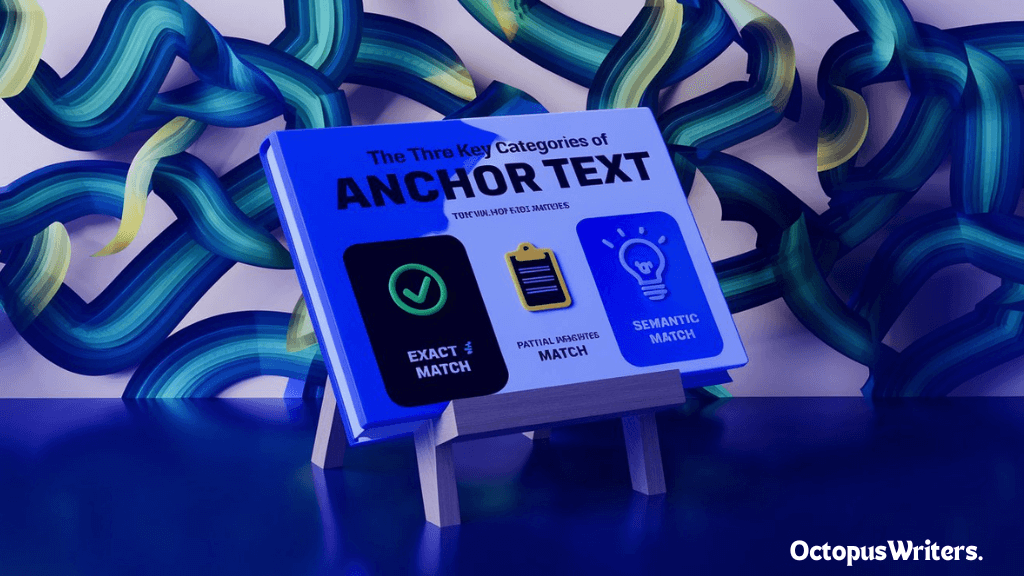
Beyond the 15 distinct types of anchor text, it’s essential to recognize three primary categories:
Combined Anchor Text
This category consists of anchor text that merges two or more types. For instance, you might link to your own website while incorporating a keyword variation, ensuring that visitors clearly identify the source of the article when they click on the link.
Organic Anchor Text
This category focuses on a single type of link but can vary in word count to enhance readability without falling into the trap of over-optimization for search engines. Bloggers often utilize this style to create natural links that flow seamlessly within their articles, avoiding repetitiveness.
Exact Match Anchor Text
Exact match anchor text contains the specific keyword or phrase that you are targeting. This type should be employed with the intent of providing supplementary information about the linked content, guiding readers towards their next action by offering clear options for further exploration.
SEO Strategies For Optimizing Anchor Text Backlinks
Surprised by the number of anchor text types? Don’t worry; there’s no need to feel overwhelmed.
You don’t need to memorize all the technical terms or use every type out there. What’s crucial is grasping the overall concept, your goals, and practical strategies to leverage anchor text effectively
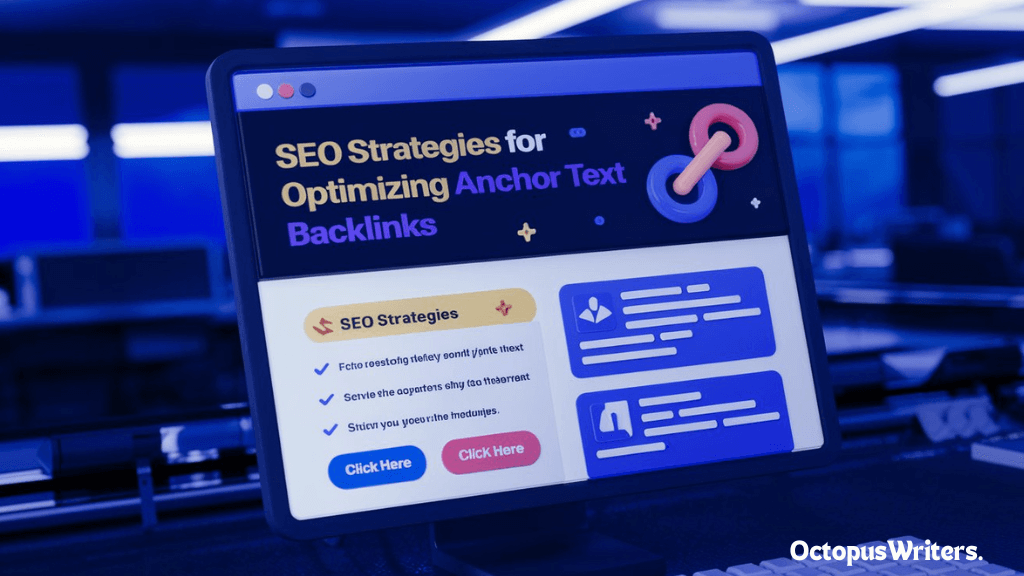
Here are some helpful tips and techniques that OctopusWriters has compiled for you:
Choose The Right Keywords
A successful anchor text strategy starts with choosing the right keywords. If you’re focusing on branded terms, that’s straightforward. However, if your aim is to discover high-volume search phrases that can attract users to your pages, it’s time for thorough keyword research.
Seek out keywords that have a significant search volume but lower competition. This combination is optimal for your strategy. Many keyword research tools can assist you in assessing which keywords are valuable to target based on investment and effort.
Create Valuable, In-Depth Content
Incorporating strong keywords into your anchor text is just the beginning. Ensure that the pages you link to are genuinely relevant to the anchor. Avoid directing users to low-quality sales pages; instead, focus on producing rich, valuable content that appeals to both users and search engines like Google.
Identify Relevant Industry Websites
Linking to relevant sites within your industry can significantly enhance the effectiveness of your anchor text. This strategy not only boosts the authority of your links but also improves your chances of attracting relevant traffic back to your pages.
Monitor Your Anchor Text
Maintaining diversity in your link-building efforts is essential, especially concerning anchor text. Excessive use of similar anchors pointing to the same page can appear spammy. Use a spreadsheet or a specialized link-building tool to track your anchor text variations and ensure a diverse approach for better outcomes. Tools like Ahrefs, SEMrush, or Moz can help you effectively manage this process.
Maintain Natural Anchor Text
Natural anchor text typically features a single type of link but can vary in word choice to enhance readability without compromising SEO. This approach is favored by bloggers who prefer diverse, organic links within their articles instead of repetitive phrases.
Steer Clear Of Empty Anchor Text Variations
Using an empty anchor text variation means your link lacks any descriptive information. This type should only be employed when there’s a specific purpose, such as directing readers to additional resources or information, like a “click here for more details” link.
Limit Over-Optimization
A page title anchor incorporates the title of your article, but this should be used judiciously. Overusing this type can be viewed as excessive optimization, which may lead to penalties from search engines if not applied correctly.
Exact match anchor text contains the specific keyword or phrase and should only be used with a clear intent for readers to navigate to another site. Avoid repetitious phrases to prevent your links from appearing spammy.
How Do Internal And External Anchor Text Differ From Each Other?
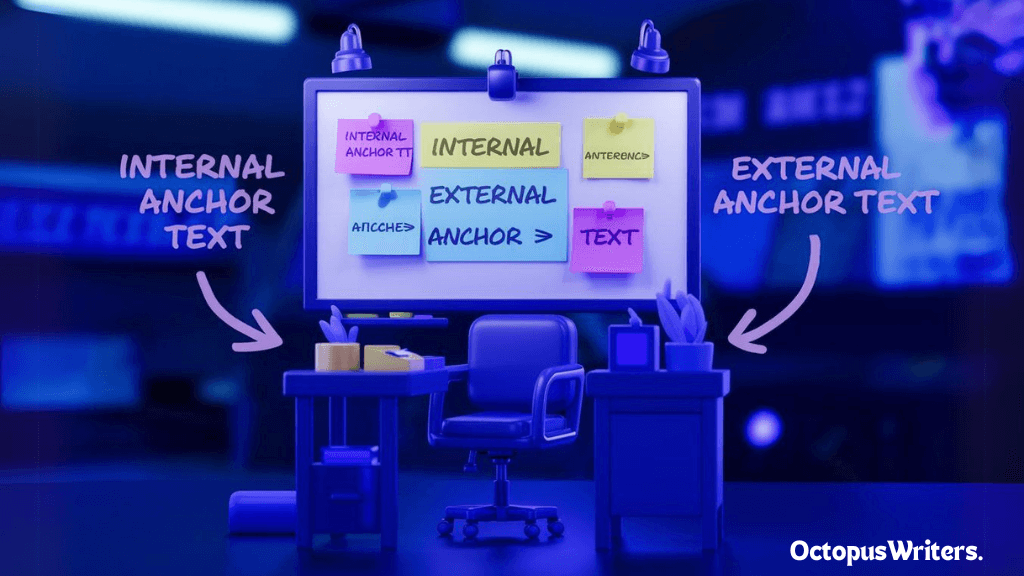
Internal anchor text refers to links that connect pages within the same website. As the owner of a site, you have the freedom to choose any anchor text for linking your own pages.
On the other hand, external anchor text connects pages across different domains. Typically, you have less control over these links. If you do have influence, ensure you are not participating in any link schemes, as this could lead to negative consequences, especially in light of Google’s Penguin algorithm update.
How To Optimize Internal Anchor Text
While this article focuses primarily on external anchor text backlinks for link building, it’s important to note that internal anchor text also contributes to enhancing your website’s SEO. Additionally, it facilitates smoother navigation for your visitors.
Don’t Stuff Keywords
Just because the content is hosted on your site doesn’t mean you should overload your anchor text with keywords. Keep it clear and concise. Anchor text should flow naturally within the sentence and not disrupt the reading experience.
Go For Variety
Using the same anchor text repetitively-like 50 times for one page-will likely raise red flags for Google. Such practices can come off as spammy and offer little value to your SEO strategy. Plus, site visitors might find it annoying if they see the same phrase repeated incessantly.
Ensure Link Relevancy
Linking to content solely to drive traffic is a misstep. Both the backlinks and the anchor text must be relevant to the target page. Users get frustrated when they expect one thing and end up on a page that has no connection to their interests.
Don’t Over-Link
Exercise caution with your linking approach. A helpful guideline is to incorporate no more than one backlink or anchor text in each paragraph. Try to refrain from packing several links into a single sentence whenever feasible.
Things To Avoid When Optimizing Anchor Text Backlinks
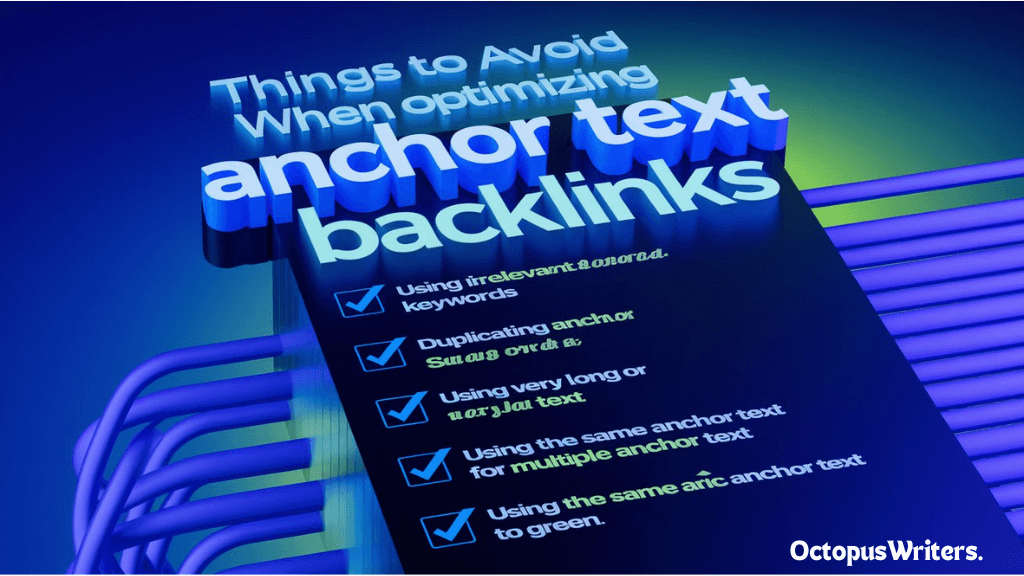
There are certain mistakes in anchor text backlink optimization that can undermine your efforts. Here are some important points to avoid:
Avoid Linking To Low-Quality Websites
Exercise caution when selecting the websites you link to; linking to spammy or low-quality domains can quickly harm your site’s SEO reputation. Always aim to link back to reputable and authoritative websites.
Avoid Empty Anchor Text Variations
Using an empty anchor text variation means your link lacks any descriptive content. This type of link should only be utilized when you have a clear purpose for directing readers to another site or resource, such as a “click here for more information” link.
Avoid Over-Optimization
A page title anchor incorporates the title of your article, but it should be used with caution. Excessive use of this anchor type may be perceived as over-optimization, potentially resulting in penalties from search engines.
Exact match anchor text features the specific keyword or phrase you’re targeting. This should only be employed when there’s a clear intent for readers to follow the link to another page. Avoid repetitive wording to ensure your links do not come across as spammy.
Conclusion
Well done! You now have a solid understanding of how anchor text in backlinks can affect your website’s search engine rankings.
Diversifying your anchor text types helps create a robust backlink profile, strengthening your site’s authority. Regularly review your backlink profile and make adjustments to align your anchor text with proven SEO strategies.
OctopusWriters believes that you can significantly grow your organic traffic through high-quality content creation and link building with optimized anchor text.
Frequently Asked Questions

What Is Anchor Text Spam? |
Anchor text spam includes:
These practices can alert Google, potentially leading to ignored links or penalties for spam. Engaging in such tactics is ineffective and harms trust with Google and your audience. |
What Is Anchor Text Ratio? |
| Anchor text ratio refers to the percentage of links within a website that utilize a specific keyword. This metric serves as a valuable indicator of the importance of keywords in your SEO strategy, allowing you to assess whether you need to enhance your content surrounding those keywords.
Ideally, you should aim for an average anchor text ratio of approximately 20%. This means that out of every 100 optimized pages, around 20% should feature the target keyword as the main variation in link text. |
What Is Anchor Text Keyword Density? |
| Another crucial aspect influencing search engine rankings is anchor text keyword density (ATKD). ATKD measures the frequency of specific words within a defined length of linked text.
You can compute ATKD by dividing the number of times a keyword appears in your anchor text variations by the total word count in those links. To calculate ATKD, apply this straightforward formula: (word count / link length) * 100 = occurrence percentage per 100 words. This metric helps determine how often particular keywords are featured on individual pages or throughout an entire website, which in turn can influence search engine rankings for those keywords. |
What Can Anchor Text Variation Do? |
| Anchor text variation plays a vital role in various SEO strategies, including enhancing click-through rates, boosting traffic, increasing visibility on social media through shares, and providing additional context about the linked content from one page to another. |

